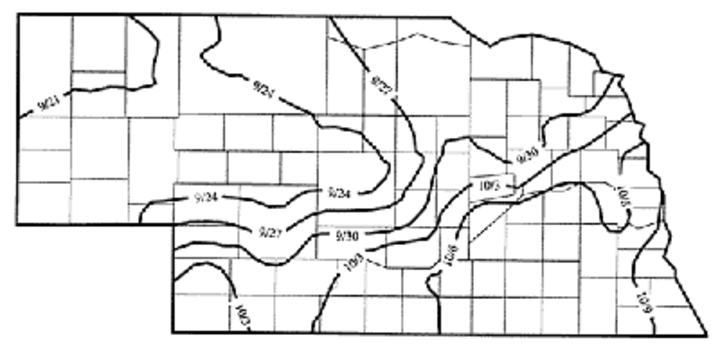April 27, 2007

Corn planting in Nebraska has been delayed by cold temperatures in mid-April and heavy rains this past week. In a companion article (Delayed Corn Planting - Costs and Considerations), we address the optimum time for planting corn, and the risks associated with delayed planting - or perhaps more importantly, planting into field conditions that compromise crop development. Below are excerpts from a CropWatch article by Roger Elmore published May 16, 2003, that discuss how planting date and hybrid comparative relative maturity interact.
Delayed planting and inappropriate hybrid selection increase the possibility of a frost occurring before crop maturity. The map shows the median probability of a 32° fall freeze and indicates that in a large portion of southeast and south-central Nebraska, half of the freezes would be likely to occur before October 6 and half would be likely to occur afterward. Ideally, I'd like to have corn mature at least two weeks before this date.
| Table 1. Relationship between CRM and GDD for days to physiological maturity (black layer) (86/50) for "normal" planting dates. | |
|
CRM |
GDD |
|
100 |
2408 |
|
105 |
2533 |
|
110 |
2657 |
|
115 |
2782 |
|
120 |
2906 |
We also should consider measures of crop maturity, which can become somewhat confusing given the variety of measurement systems available. While there is no single standard, researchers Bob Nielsen (Purdue University) and Peter Thomison (Ohio State University) clarified the relationship between hybrid comparative relative maturity (CRM) and growing degree days (GDD). The CRM system they used is similar to that of Pioneer Hi-Bred International and is thought of as days required from planting to maturity. The equation generated for this relationship was:
Hybrid GDU to black layer = 24.908x - 82.821 (R2 = 0.9273) where x is CRM.
For every one-day increase in CRM, GDD requirements appear to increase about 25 units. Table 1 shows this relationship too. Based on this table, a 115 CRM hybrid would use about 2800 GDD to mature with a normal planting date. The last five words are important! Research cited by Nielsen and Thomison shows that:
- although delayed planting shortens the growing season, corn hybrids adjust to this well, and
- adapted hybrids can be planted into early June without major risks of fall frost injury.
Nielsen and Thomison found that delayed planting decreases hybrid GDD to physiological maturity (black layer) by about 6.8 GDD per day. Thus, we can plant full-season hybrids much later than we used to think and they will still mature before the risk of fall frost is high. With the 6.8 GDD loss per day with delayed planting, a hybrid planted on the May 30 would behave much like a hybrid with 204 less GDD planted on May 1. Table 2 combines the relationship of CRM and GDD with the concept of reduced GDD requirements for delayed planting: A 115 CRM hybrid (2782 GDD) planted on May 15 would behave like a 111 CRM hybrid and when planted on May 30 it would behave like a 107 CRM (2578 GDD) hybrid. If planted on May 30 this hybrid should mature around September 14 in southeast and southern Nebraska and around September 27 in central and northeast Nebraska.
| Table 2. Relationship between CRM and GDD for days to physiological maturity (black layer) (86/50) for normal and delayed planting dates. | |||||
|
For a "normal" |
For late planting dates | ||||
| May 15 planting date | May 30 planting date | ||||
|
CRM |
GDD |
CRM |
GDD |
CRM |
GDD |
|
100 |
2408 |
96 |
2306 |
92 |
2204 |
|
105 |
2533 |
101 |
2431 |
97 |
2329 |
|
110 |
2657 |
106 |
2555 |
102 |
2453 |
|
115 |
2782 |
111 |
2680 |
107 |
2578 |
|
120 |
2906 |
116 |
2804 |
112 |
2702 |
The probability of a 32° freeze occurring before maturity is less than 26% for most of the corn-producing areas in Nebraska. This is about a little more than a week earlier than the average date for a 32° frost. That may be too close for comfort for some of us. A 120 CRM hybrid planted on May 30 would have nearly a 50% probability of frost damage before maturity. Fortunately, we grow a few hybrids of this maturity.
It is not necessary to change to earlier maturing hybrids until early June for most of Nebraska's corn production area if hybrids require 115 CRM or less to mature. Even considering this, when fields are dry enough to plant, I'd plant my full-season hybrids first. We may be blessed with more rain in May that could delay planting even more! If planting dates are delayed into mid-June, then you may want to plant crops other than corn.
Sources
Delayed Planting and Hybrid Maturity Decisions. R.L. Nielsen, and Peter Thomison. 2002. Purdue Coop. Extension Service. (PDF 149 KB)
Roger Elmore
Formerly Extension Crops Specialist
South Central Ag Lab
